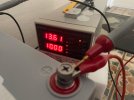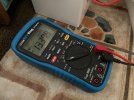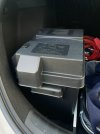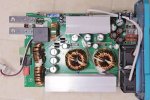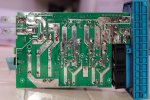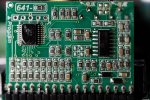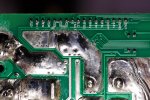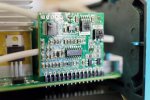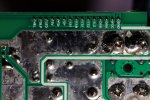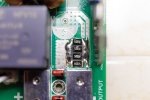DigitalCorpus
Active Member
- Joined
- Oct 17, 2023
- Messages
- 111
- Reaction score
- 71
- Location
- California
- Country
- United States
- Dash Cam
- Vantrue N4 Pro
I'm sorry for pinging you both, @GPak & @Agie, but I want to thank you both for conversing with me on this topic earlier on.
Honestly, I wasn't planning on a title that was ambiguous/clever/redundant/dumb/smart. Hi, I'm [DigitalCorpus] starting my build thread in spirit to what GPak has done in his thread, to connect my dash cam to a LiFePO4 battery (house battery), which will need a DC-to-DC (direct current to direct current) regulator between my DIN H5, BCI Group 47 AGM starter battery and a 100 Ah LiFePO4 house battery. At worst, a 100 Ah is ~40% more capacity than I'll need, and at best ~30% of maximum capacity of it used. Most people will not need to go to the lengths I will be doing here, and if you're looking for something simple, head back to the thread I linked above. You'll need an intermediate electrical knowledge, and be comfortable enough in to know that crimped connectors are better than soldered connectors depending on use case, or have enough money to pay someone who knows this.
I'm going to be linking to many specific products through the course of this thread. A listing, link, or mention of a product is an endorsement or guaranty of the product; though it may be an endorsement of the technology the product represents.
I'm not chasing decibels and I'm not camping on cliff faces 'cause I'm in a hatchback. However, I'm in a unique area of the US that has beaches a couple hours away and Death Valley on the other side of the mountains to my north. Most of the reason for starting the above "thought trek" is knowing how much power the N4P needs, though if I'm gonna have a battery this big, It might as well power more than just my dash cam. I've been around a few hybrids and they can have a dandy feature of using the starter battery down to a point, turning the engine on and charging it, then turn the engine off again, ad infinitum. My ICE car only does this cycle once and I'm keenly interested to see if I can extend the duration, directly or indirectly. Hard to jerry rig in a power station for this type of loading, and charging.
Just in case anyone is interested in following along and is new to electrical power, here are some terms I may be using along the way:
Edit Reason: Moved Parts to post 2
Honestly, I wasn't planning on a title that was ambiguous/clever/redundant/dumb/smart. Hi, I'm [DigitalCorpus] starting my build thread in spirit to what GPak has done in his thread, to connect my dash cam to a LiFePO4 battery (house battery), which will need a DC-to-DC (direct current to direct current) regulator between my DIN H5, BCI Group 47 AGM starter battery and a 100 Ah LiFePO4 house battery. At worst, a 100 Ah is ~40% more capacity than I'll need, and at best ~30% of maximum capacity of it used. Most people will not need to go to the lengths I will be doing here, and if you're looking for something simple, head back to the thread I linked above. You'll need an intermediate electrical knowledge, and be comfortable enough in to know that crimped connectors are better than soldered connectors depending on use case, or have enough money to pay someone who knows this.
I'm going to be linking to many specific products through the course of this thread. A listing, link, or mention of a product is an endorsement or guaranty of the product; though it may be an endorsement of the technology the product represents.
Background
I live in Southern California (colloquialy known as SoCal) and have a penchant for electronics and technology. I have moved from a '97 VW Passat TDI to a '23 Honda Civic 1.5Tand decided to pick up a dash cam. For the past 15+ years, half of my driving takes place as night and for that reason, I chose a Vantrue N4 Pro in order to read license plates, otherwise it is almost useless half of the time. Unfortunately, Vantrue hasn't or cannot optimize the boot time of the N4 Pro (N4P hereon) nor its power usage so the need for an auxiliary power source is needed if I want it to record for more than when the *engine* is on.Intended functionality
- Power the N4P in Time Lapse or Parking modes
- Sustain the starter battery during Auto Idle Stop (more details later)
- Jump the starter battery from the LiFePO4 battery
- Selectively remove the LiFePO4 from the factory electrical system
Fun functionality
(Used to field ideas and let them live or die w/o spending money on them)- Power a GSM/LTE booster/repeater
- Galvanically isolate the LiFePO4 battery
- Power 1 kW, 2 kVA inverter (if this exists, I don't know the realm of specs)
- Jump the starter battery of a different car from the LiFePO4 battery, directly or indirectly
- Power auxiliary lighting switched with ignition
- Data logging of LiFePO4 & AGM usage
- Kill switches that function for safety and anti-theft
- Low power SBC (single board computer) for possibly remotely connecting into my N4P and downloading the footage as a backup
Where did I start & why this route?
I started with GPak's thread. The economics of the batteries for powering dash cams during parking mode is poor and causes these types of pack to have fairly high prices. I wish these companies the best and they have to make a profit in order stay in business. I am by no means maligning them as the packs are straight forward in their use case for those who want one and need just a little power. If you want to save money and are able to DIY some things, then I'd suggest going back to GPak's thread. If you just want to "DIY" it and build out a dual battery system, you're going to dip your toes into the high power car audio and/or the overlanding crowds. Everyone's car/truck/van/UV/RV is different and what they want the power for is similarly different.I'm not chasing decibels and I'm not camping on cliff faces 'cause I'm in a hatchback. However, I'm in a unique area of the US that has beaches a couple hours away and Death Valley on the other side of the mountains to my north. Most of the reason for starting the above "thought trek" is knowing how much power the N4P needs, though if I'm gonna have a battery this big, It might as well power more than just my dash cam. I've been around a few hybrids and they can have a dandy feature of using the starter battery down to a point, turning the engine on and charging it, then turn the engine off again, ad infinitum. My ICE car only does this cycle once and I'm keenly interested to see if I can extend the duration, directly or indirectly. Hard to jerry rig in a power station for this type of loading, and charging.
Just in case anyone is interested in following along and is new to electrical power, here are some terms I may be using along the way:
DC - Me, or dash cam, or direct current. Take your pick.
Breaker - Circuit breaker. Safety device for electrically breaking a connection between two points. This can be reset physically and the break is not permanent.
Fuse - Like a breaker, but one time use.
Cap - Depends on context: short for capacity, referencing the [electrical] current capacity of the battery OR for for capacitor, a passive electronic device for holding electricity.
Cell - What most people call a battery. The is the simplest, physical part of a battery. If you see voltages referenced below 5 V, we're talking about [battery] cells.
Battery - A collection of cells in series and/or parallel to meet a standard voltage and/or capacity for an electrical system standard.
AGM - Absorbent Glass Mat type of lead acid batteries. More expensive than a regular flooded lead acid battery, but still lead acid.
LiFePO4/LFP - Lithium (Li) Iron (Fe) Phosphate (PO4), a widely popular lithium battery chemistry that prioritizes safety over power density and discharge current.
Overland(ing) - Point to a spot on a map and drive there while being self-sufficient. Spend the night, or the week.
Starter battery - The battery, usually lead acid, used for turning over your engine to start it. Practically useful for short term, low DoD usage.
DoD - Depth of Discharge, how much your discharge a battery
House battery - One of a few ways a dual battery system can be setup, and this battery, usually LFP, is for longer term power for use when the engine is not running.
ODM - Original Device Manufacturer. Common is electronics, like laptops or power supplies, but also here with LFP batteries.
BMS - Battery Management System, provides the basic electrical system mechanisms for operating a battery.
Galvanic Isolation - A term used in electronics meaning that DC cannot flow between different sides that are isolated using this means.
Reverse Charging - Jump starting
Shore power - AC power input to charge a dual battery system.
TEC - Thermoelectric cooler, aka a Peltier device, uses some fun material properties that can turn voltage into a temperature differential, and vise versa.
NO & NC - Normally Open and Normally Closed terms for the state of a relay when power is not applied to the coil
Edit Reason: Moved Parts to post 2
Last edited:

